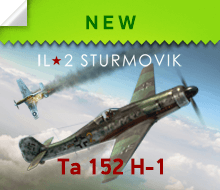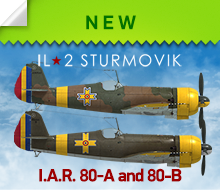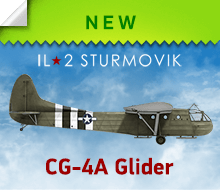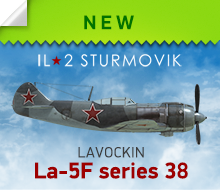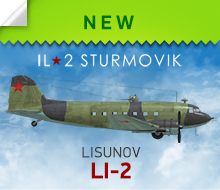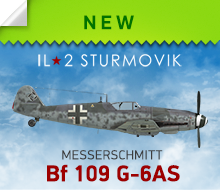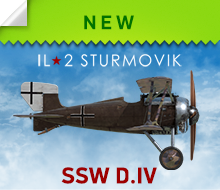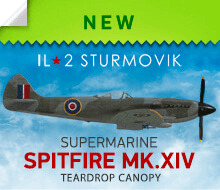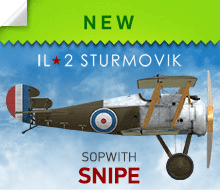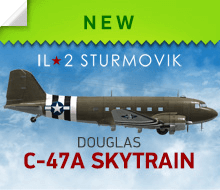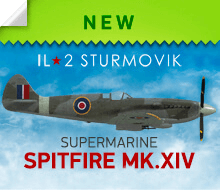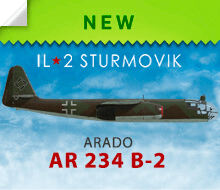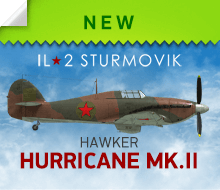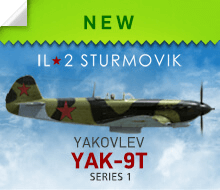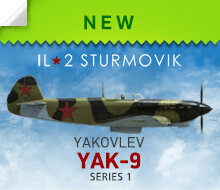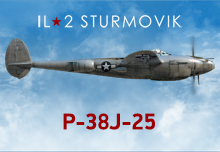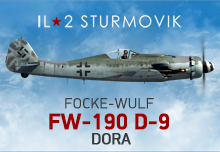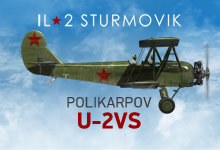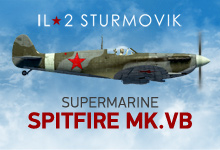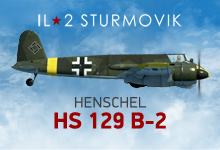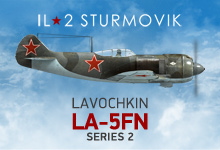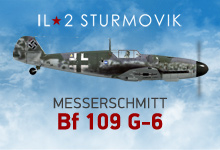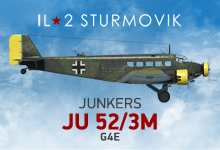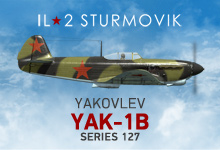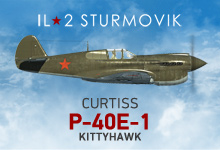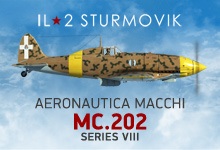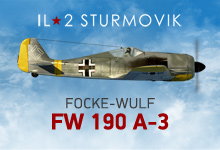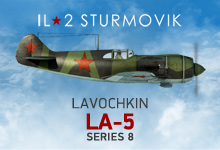Cart: 0
Total: 0

Collector Planes
Owners of any IL-2 Sturmovik: Great Battles title can supplement his or her collection of aircraft by buying special Collector Planes. They are usable in all modes of gameplay. However, availability in Campaign mode depends on historical availability of this plane in that theater or battle.
Ta 152 H-1
The Ta 152 was the last creation of the German aircraft designer Kurt Tank, which managed to take part in combat operations during the Second World War. This aircraft was the culmination of the evolution of the Fw 190 fighter and Germany's most advanced piston fighter. It was in development for a long time, several years, and appeared at the very end of the war. During the development, several modifications of the original Fw 190 were produced, which finally led to the Ta 152 - the name "Fw" was changed to "Ta" in recognition of the designer's merits.
Compared to the Fw 190D "Dora", the wingspan was significantly increased for better maneuverability at high altitudes, the fuselage was longer, and the new Jumo-213E engine was equipped with two boost systems: MW-50 (water-methanol mixture injection for low and medium altitudes) and GM-1 (nitrous oxide for high altitudes). The "Dora" engine was already characterized by a high degree of automation and regulation and thus complexity, but here the Germans went even further - the engine was equipped with a two-stage three-speed (!) supercharger.
As you can see, these improvements were made for high-altitude combat, where the Ta 152 had to outperform the Mustangs and Spitfires of the Allies - the threat from the bomber armadas climbing higher and higher was growing every year. The plane had a pressurized cockpit and could reach a speed of 750 km/h at an altitude of 12 km, and its ceiling was 14 km! Think about it - a piston fighter that could climb and fight above modern jetliners. Its armament is also respectable, even by late WWII standards: 30mm MK 108 and two 20mm MG-151/20 cannons allowed it to destroy any air target.
The Ta 152 went into production at the end of the war and appeared in the skies of Germany in January-February 1945, but due to the disparity of forces, they had no effect on the course of hostilities: they were produced in very small numbers (about 25 H-1s). They remained in history as a monument to German wartime engineering and design.
Compared to the Fw 190D "Dora", the wingspan was significantly increased for better maneuverability at high altitudes, the fuselage was longer, and the new Jumo-213E engine was equipped with two boost systems: MW-50 (water-methanol mixture injection for low and medium altitudes) and GM-1 (nitrous oxide for high altitudes). The "Dora" engine was already characterized by a high degree of automation and regulation and thus complexity, but here the Germans went even further - the engine was equipped with a two-stage three-speed (!) supercharger.
As you can see, these improvements were made for high-altitude combat, where the Ta 152 had to outperform the Mustangs and Spitfires of the Allies - the threat from the bomber armadas climbing higher and higher was growing every year. The plane had a pressurized cockpit and could reach a speed of 750 km/h at an altitude of 12 km, and its ceiling was 14 km! Think about it - a piston fighter that could climb and fight above modern jetliners. Its armament is also respectable, even by late WWII standards: 30mm MK 108 and two 20mm MG-151/20 cannons allowed it to destroy any air target.
The Ta 152 went into production at the end of the war and appeared in the skies of Germany in January-February 1945, but due to the disparity of forces, they had no effect on the course of hostilities: they were produced in very small numbers (about 25 H-1s). They remained in history as a monument to German wartime engineering and design.
I.A.R. 80-A and 80-B
The IAR-80 was a Romanian low-wing monoplane originally designed in the late 1930s by Industria Aeronautică Română (IAR, or Romanian Aeronautic Industry in English). First flown in 1939, the IAR-80 was comparable to other fighter aircraft designs of the late 1930s and would remain in service with the Royal Romanian Air Force throughout World War II until the end of the war in May 1945.
The armament of the IAR-80 initially consisted of Belgian-made Fabrique Nationale FN 7.92 mm light machine guns, which were a licensed version of the Browning M1919 machine gun. These machine guns would eventually be replaced by 13.2 mm FN heavy machine guns and German 20 mm MG FF/M and MG 151/20 cannons. In 1941, the IAR-80 was modified to become a dive bomber and thus became the IAR-81. This new model was fitted with a bomb cradle under the fuselage which would throw the bomb clear of the propeller when the bomb was released.
The first production IAR 80s were completed in January 1941, and they were in action against the Soviets from the first day of Operation Barbarossa on June 22, 1941. IAR-80s and 81s both saw action during the Battle of Stalingrad and later took part in combat over the Kuban and the Crimea throughout 1943 and into 1944. Meanwhile, in August 1943 IAR-80s took part in the defense of the Romanian oil fields at Ploesti for the first time against US Army Air Force B-24 heavy bombers. Further defensive missions would be flown over Romania through the summer of 1944 against American heavy bomber raids. After Romania switched sides in August 1944 and joined the Allies, IAR-80s and IAR-81s fought alongside the Soviets until the war ended in May 1945.
In addition to Quick Mission Builder, Advanced Quick Mission Generator and Multiplayer modes, you can fly it in Career mode during Battle of Stalingrad (Grp. 6 BoPi ARR and Grp. 8 Vânătoare ARR) and Battle of Kuban (I.A.R. 80-A in Grp. 3 Vânătoare ARR and I.A.R. 80-B in Grp. 4 Vânătoare ARR).
The armament of the IAR-80 initially consisted of Belgian-made Fabrique Nationale FN 7.92 mm light machine guns, which were a licensed version of the Browning M1919 machine gun. These machine guns would eventually be replaced by 13.2 mm FN heavy machine guns and German 20 mm MG FF/M and MG 151/20 cannons. In 1941, the IAR-80 was modified to become a dive bomber and thus became the IAR-81. This new model was fitted with a bomb cradle under the fuselage which would throw the bomb clear of the propeller when the bomb was released.
The first production IAR 80s were completed in January 1941, and they were in action against the Soviets from the first day of Operation Barbarossa on June 22, 1941. IAR-80s and 81s both saw action during the Battle of Stalingrad and later took part in combat over the Kuban and the Crimea throughout 1943 and into 1944. Meanwhile, in August 1943 IAR-80s took part in the defense of the Romanian oil fields at Ploesti for the first time against US Army Air Force B-24 heavy bombers. Further defensive missions would be flown over Romania through the summer of 1944 against American heavy bomber raids. After Romania switched sides in August 1944 and joined the Allies, IAR-80s and IAR-81s fought alongside the Soviets until the war ended in May 1945.
In addition to Quick Mission Builder, Advanced Quick Mission Generator and Multiplayer modes, you can fly it in Career mode during Battle of Stalingrad (Grp. 6 BoPi ARR and Grp. 8 Vânătoare ARR) and Battle of Kuban (I.A.R. 80-A in Grp. 3 Vânătoare ARR and I.A.R. 80-B in Grp. 4 Vânătoare ARR).
CG-4A Glider
Military gliders, as a mass phenomenon, belong almost entirely to the World War II era. The development of this class of airborne equipment began in the pre-war years, and they were used in the war by almost all the major participants. The most significant combat episode involving the use of gliders was, of course, the Allied invasion of Nazi-occupied France in June 1944. The use of gliders was massive: more than 800 were used to transport infantry units and their equipment during Operation Overlord, and the main hero of this action was the American CG-4 glider. In total, more than 2000 gliders of this model were delivered to England, but only a little more than 1000 were combat-ready at the beginning of the operation. Still a huge number. A few months later, during the ill-fated airborne Operation Market Garden, more than 1500 gliders were used.
It is interesting to note that the "large military glider" as a class, as suddenly as it appeared before the Second World War, disappeared almost immediately after it. The disappearance occurred before the aviation epoch had changed forever, when new anti-aircraft weapons or new interceptors would have devalued all the advantages of this type of vehicle, and the development of helicopter technology had not yet reached the level to become an important factor in the capabilities of airborne forces. However, the use of gliders was almost immediately abandoned, most likely due to high losses among the airborne troops which reached 40%. Nevertheless, you have the opportunity to experience this period of history in the world of our simulator.
In our simulator, the visual model of the glider was restored with great care and our engineers recreated in its new virtual life all the main features of its control and use. It should be noted that this is a new class of objects for our simulator and we have developed a number of technologies to make its realization possible - for example, a flexible towing cable. In addition to Quick Mission Builder and Multiplayer modes, you can fly it in its own scenario "Chicago Night" if you have Normandy module and it's planned to add glider flying scenarios to Advanced Quick Mission mode soon. If you have Normandy and/or Bodenplatte modules and C-47 Collector Plane, you can get glider towing missions during major airborne operations - Overlord, Market Garden and Varsity.

It is interesting to note that the "large military glider" as a class, as suddenly as it appeared before the Second World War, disappeared almost immediately after it. The disappearance occurred before the aviation epoch had changed forever, when new anti-aircraft weapons or new interceptors would have devalued all the advantages of this type of vehicle, and the development of helicopter technology had not yet reached the level to become an important factor in the capabilities of airborne forces. However, the use of gliders was almost immediately abandoned, most likely due to high losses among the airborne troops which reached 40%. Nevertheless, you have the opportunity to experience this period of history in the world of our simulator.
In our simulator, the visual model of the glider was restored with great care and our engineers recreated in its new virtual life all the main features of its control and use. It should be noted that this is a new class of objects for our simulator and we have developed a number of technologies to make its realization possible - for example, a flexible towing cable. In addition to Quick Mission Builder and Multiplayer modes, you can fly it in its own scenario "Chicago Night" if you have Normandy module and it's planned to add glider flying scenarios to Advanced Quick Mission mode soon. If you have Normandy and/or Bodenplatte modules and C-47 Collector Plane, you can get glider towing missions during major airborne operations - Overlord, Market Garden and Varsity.
Developed in partnership with Ugra Media studio

La-5F series 38
In terms of tactical characteristics, the La-5F was an evolutionary improvement of the La-5 on the way to the La-5FN. There weren't enough FN engines to power all the fighters produced until 1944, so the mass production of the La-5F was inevitable through 1943 with continued improvements here and there. As working conditions and resources improved, production standards gradually rose, resulting in, among other things, better aircraft: La-5s produced in summer-autumn 1943 became about 150 kg lighter.
The biggest improvement from the pilot's point of view was the new bubble top canopy with emergency jettison (even our La-5FN series didn't yet have emergency jettison). This eliminated one of their biggest fears, not being able to bail out of a burning aircraft, which caused many to fly with open cockpits, which severely limited the speed of their aircraft. Now they could put that fear to rest and enjoy the improved field of vision - the main reason why bubble top variants became the norm in all air forces later in the war, despite the increased drag they had compared to older canopy designs.
To sum up, the La-5F in the sim is a bit more agile than the older La-5, turns a bit better than even the FN, offers a better field of view, and is slower than the FN in level flight and climb because of the more powerful engine of the latter. With a cockpit modeled for today's standards, it is a nice addition for the second half of the 1943 timeframe.
The biggest improvement from the pilot's point of view was the new bubble top canopy with emergency jettison (even our La-5FN series didn't yet have emergency jettison). This eliminated one of their biggest fears, not being able to bail out of a burning aircraft, which caused many to fly with open cockpits, which severely limited the speed of their aircraft. Now they could put that fear to rest and enjoy the improved field of vision - the main reason why bubble top variants became the norm in all air forces later in the war, despite the increased drag they had compared to older canopy designs.
To sum up, the La-5F in the sim is a bit more agile than the older La-5, turns a bit better than even the FN, offers a better field of view, and is slower than the FN in level flight and climb because of the more powerful engine of the latter. With a cockpit modeled for today's standards, it is a nice addition for the second half of the 1943 timeframe.
Li-2
Lisunov Li-2 was a license-built Soviet version of the DC-3. Despite looking similar, it was quite different to the original because it was adapted for Soviet production - all the measurements were converted to metric system, it had different instruments, cargo doors, landing gear, even the engines.
This Soviet C-47 sibling was like a gunship wannabe - it had turrets AND a forward-firing machine gun. An armed transport aircraft with paratroopers and cargo inside - how much more versatile can you get? Well, add the bomb-carrying capability to this mix and you get a machine that ticks nearly all the boxes you ever wanted.
Usually going the 'jack of all trades' route means sacrificing something in every trade, but the USSR needed versatile aircraft. While the Western Allies during the war had plenty of long-range fighters to cover their bombers and unarmed transport aircraft and enjoyed air superiority most of the time, Soviet VVS usually did not have this luxury.

This Soviet C-47 sibling was like a gunship wannabe - it had turrets AND a forward-firing machine gun. An armed transport aircraft with paratroopers and cargo inside - how much more versatile can you get? Well, add the bomb-carrying capability to this mix and you get a machine that ticks nearly all the boxes you ever wanted.
Usually going the 'jack of all trades' route means sacrificing something in every trade, but the USSR needed versatile aircraft. While the Western Allies during the war had plenty of long-range fighters to cover their bombers and unarmed transport aircraft and enjoyed air superiority most of the time, Soviet VVS usually did not have this luxury.
Developed in partnership with Ugra Media studio

Bf 109 G-6AS
Bf-109 G-6AS has been designed as a high-altitude interceptor and appeared in the Western Europe skies during late Spring 1944. 686 aircraft were built, 226 from scratch and 460 upgraded from G-6 modification aircraft during the repairs. The engine, DB605AS, was a modification of the DB605A. The installation of the bigger supercharger from the DB603 engine has increased the critical altitude and flight characteristics at high altitudes. The engine cowling became bigger, but it had a more aerodynamic form compared to a standard G6 cowling.
In addition to Quick Mission Builder, Advanced Quick Mission Generator and Multiplayer modes, you can fly it in Career mode during Battle of Normandy and Battle of Bodenplatte timeframes.
In addition to Quick Mission Builder, Advanced Quick Mission Generator and Multiplayer modes, you can fly it in Career mode during Battle of Normandy and Battle of Bodenplatte timeframes.
SSW D.IV
The SSW D.IV came very late to the Great War to change Germany’s fortunes, but what machines did make it to front-line squadrons acquitted themselves well. The SS.DIV was the end result of a robust line of aircraft that saw service in the war and it came with a unique feature. The 200-hp SH.IIIa rotary engine had a crankshaft that rotated opposite of the engine and the propeller ’s rotation in an attempt to reduce the torque. The four-bladed propeller gave it a fast rate of climb and a high speed. The SS.DIV was even faster than Germany’s mainstay front-line fighter, the very successful Fokker D.VII. It was also very maneuverable, but reportedly had nasty stall behavior when pushed too far. The SS.DIV was armed with two 2 × 7.92mm machine guns.
In addition to Quick Mission Builder and Multiplayer modes, you can fly it in Career mode during Flying Circus timeframes if you own both this collector plane and either of Flying Circus volumes. In addition, in this case Against the Tide historical campaign on the Flying Circus Western Front map will open up for you in the game for free - you'll become one of the Jasta (Jagdstaffel) 22 pilots that received these newest biplanes shortly before the end of the World War I.

In addition to Quick Mission Builder and Multiplayer modes, you can fly it in Career mode during Flying Circus timeframes if you own both this collector plane and either of Flying Circus volumes. In addition, in this case Against the Tide historical campaign on the Flying Circus Western Front map will open up for you in the game for free - you'll become one of the Jasta (Jagdstaffel) 22 pilots that received these newest biplanes shortly before the end of the World War I.
Developed in partnership with Ugra Media studio

Spitfire Mk.XIV w/ Teardrop Canopy
The Spitfire Mk. XIV, which entered service at the end of 1943, was originally built with a “high back” rear fuselage which restricted visibility to the rear of the plane. To rectify this problem, development of the Mk. XIV with a cut-down rear fuselage and tear-drop canopy began to be developed and built at the end of 1944.
These improved Spitfire Mk. XIVs featured full-span wings and were equipped with 2x .50 cal. machine guns and 2x 20 mm Hispano cannons; they could also be fitted with bomb racks to carry 250 lb. and 500 lb. bombs. The same Griffon engine that powered the original Mk. XIVs also powered this new model. For reconnaissance work, a camera could be fitted behind the canopy; such planes were known as Fighter Reconnaissance Mk. XIVs and were fitted with clipped wingtips as standard.
Spitfire Mk. XIVs with the cut-down rear fuselage and tear-drop canopy started entering service with the Royal Air Force’s 2nd Tactical Air Force in March 1945 and continued in operational service after the end of the war in Europe in May 1945. These improved Mk. XIVs also began to be sent to the South-East Asian Theater in June 1945 but arrived too late to see any combat against the Japanese.
These improved Spitfire Mk. XIVs featured full-span wings and were equipped with 2x .50 cal. machine guns and 2x 20 mm Hispano cannons; they could also be fitted with bomb racks to carry 250 lb. and 500 lb. bombs. The same Griffon engine that powered the original Mk. XIVs also powered this new model. For reconnaissance work, a camera could be fitted behind the canopy; such planes were known as Fighter Reconnaissance Mk. XIVs and were fitted with clipped wingtips as standard.
Spitfire Mk. XIVs with the cut-down rear fuselage and tear-drop canopy started entering service with the Royal Air Force’s 2nd Tactical Air Force in March 1945 and continued in operational service after the end of the war in Europe in May 1945. These improved Mk. XIVs also began to be sent to the South-East Asian Theater in June 1945 but arrived too late to see any combat against the Japanese.
Sopwith Snipe
The Sopwith Snipe was a late-war entry into combat and represented the pinnacle of British Great War fighter aircraft. It began replacing Sopwith Camels in the autumn of 1918 and went on to server post-war after the Armistice was signed in November 1918. The Snipe was the last British fighter to come equipped with a rotary engine – the Bentley BR2. The BR.2 made 230 hp which allowed the Snipe to be a little faster than the Camel. Although not blistering fast by 1918 standards, it was a very maneuverable fighter. The Snipe had a faster rate of climb than the Camel and it could fight superior German machines more effectively at higher altitudes. The Snipe came armed with two .303 machine guns and had improved visibility over its predecessor. It could also carry a small bomb load like the Camel. It’s combat life was short, but both British and Australian squadrons had success with it before the war ended.

Developed in partnership with Ugra Media studio

C-47A
The C-47 Skytrain, which was a militarized version of the highly successful DC-3 civilian transport and airliner, was the workhorse cargo carrier of the USAAF during WWII. It also served with the U.S. Navy as the R4D-5 and with British forces where it was known as the Dakota. The C-47 was reliable, versatile and rugged. It could drop supplies to beleaguered ground forces, drop paratroopers during an invasion, tow gliders behind enemy lines and deliver desperately needed supplies to forward airfields all over the world.
The C-47 saw action in every WWII theater including both the Western and Eastern Fronts. The version specially designed to carry paratroopers was known as the C-53 Skytrooper, but were produced in much smaller numbers and generally also identified as a C-47 upon first glance. The C-47B had turbo-superchargers added so they could fly over the Himalaya Mountains or the ‘Hump’ as it was known into China from India to re-supply Allied troops there.
Over 5,300 C-47A models were built during the war. The C-47 was affectionally called the ‘Gooney Bird’ by soldiers, sailors and airmen of the Allies. The RAF received over 2,000 aircraft as part of the Lend-Lease program and were used wherever British troops saw action.
So successful was the basic design that there was a Soviet license-built version called the Lisunov Li-2 which served not only as a transport, but also a bomber in emergency situations. There was even a Japanese built version called the L2D codenamed ‘Tabby’ by the Allies.
Much like our beloved and popular German Junkers Ju 52, you will be able to use our C-47A is just as the Allies did. You will be able to fly important supply missions and drop airborne troops behind enemy lines in Normandy, the Low Countries and even Germany itself near wars end.

The C-47 saw action in every WWII theater including both the Western and Eastern Fronts. The version specially designed to carry paratroopers was known as the C-53 Skytrooper, but were produced in much smaller numbers and generally also identified as a C-47 upon first glance. The C-47B had turbo-superchargers added so they could fly over the Himalaya Mountains or the ‘Hump’ as it was known into China from India to re-supply Allied troops there.
Over 5,300 C-47A models were built during the war. The C-47 was affectionally called the ‘Gooney Bird’ by soldiers, sailors and airmen of the Allies. The RAF received over 2,000 aircraft as part of the Lend-Lease program and were used wherever British troops saw action.
So successful was the basic design that there was a Soviet license-built version called the Lisunov Li-2 which served not only as a transport, but also a bomber in emergency situations. There was even a Japanese built version called the L2D codenamed ‘Tabby’ by the Allies.
Much like our beloved and popular German Junkers Ju 52, you will be able to use our C-47A is just as the Allies did. You will be able to fly important supply missions and drop airborne troops behind enemy lines in Normandy, the Low Countries and even Germany itself near wars end.
Developed in partnership with Ugra Media studio

Spitfire Mk.XIV
The Spitfire Mk. XIV was the first of the Griffon-powered Spitfires to be powered by the Griffon 65 inline engine, which was fitted with a two-stage supercharger to overcome the poor high-altitude performance of the earlier, single-stage Griffon engines. At maximum power, this new engine model could produce 2,050 horsepower. In addition to the new engine, a new five-bladed Rotol propeller was also fitted to the plane.
The initial armament of the Mk. XIV consisted of 0.303 Browning light machine guns and 20 mm Hispano Mk. II cannons fitted in the wings. Later, during the summer of 1944, the 0.303s were replaced with a pair of Browning M2 0.50 caliber heavy machine guns. To gain extra performance while chasing V-1 flying bombs in the summer of 1944, some squadrons removed the machine guns and faired over the firing ports. A lead-computing gyroscopic gunsight could also be fitted.
The Spitfire Mk. XIV could be fitted with bomb racks to carry 250 lb. and 500 lb. bombs, although operationally this was limited to one squadron from February 1945. To improve turning performance, Mk. XIVs began being fitted with clipped wingtips in the winter of 1944-45.
Production of the Spitfire Mk. XIV began in late 1943, and the first handful of planes was issued to No. 610 Squadron at the end of December 1943. Besides hunting for V-1s, this model of the Spitfire eventually became the 2nd Tactical Air Force’s main high-altitude air superiority fighter over northwestern Europe. Mk. XIVs began to be sent to southeastern Asia in June 1945, but these saw no usage against the Japanese.All told, 957 Mk. XIV Spitfires were built. After the end of World War II, the plane was exported to a number of foreign countries, including Belgium, India, and Thailand.
The initial armament of the Mk. XIV consisted of 0.303 Browning light machine guns and 20 mm Hispano Mk. II cannons fitted in the wings. Later, during the summer of 1944, the 0.303s were replaced with a pair of Browning M2 0.50 caliber heavy machine guns. To gain extra performance while chasing V-1 flying bombs in the summer of 1944, some squadrons removed the machine guns and faired over the firing ports. A lead-computing gyroscopic gunsight could also be fitted.
The Spitfire Mk. XIV could be fitted with bomb racks to carry 250 lb. and 500 lb. bombs, although operationally this was limited to one squadron from February 1945. To improve turning performance, Mk. XIVs began being fitted with clipped wingtips in the winter of 1944-45.
Production of the Spitfire Mk. XIV began in late 1943, and the first handful of planes was issued to No. 610 Squadron at the end of December 1943. Besides hunting for V-1s, this model of the Spitfire eventually became the 2nd Tactical Air Force’s main high-altitude air superiority fighter over northwestern Europe. Mk. XIVs began to be sent to southeastern Asia in June 1945, but these saw no usage against the Japanese.All told, 957 Mk. XIV Spitfires were built. After the end of World War II, the plane was exported to a number of foreign countries, including Belgium, India, and Thailand.
Arado Ar 234 B-2
The Arado Ar 234 B-2 was a development of the Ar 234 A reconnaissance plane, which had first seen action over the beaches of Normandy in early August 1944. Unlike the Ar 234 A, the Ar 234 B-2 was built as a bomber aircraft and was fitted with conventional tricycle landing gear. In addition to flying as a bomber, the plane could be fitted with a pair of cameras for reconnaissance work. In this latter case, the plane was known as the Ar 234 B-1.
The Ar 234 B-2 was powered by a pair of Junkers Jumo 004 turbojets, which were also fitted to the Messerschmitt Me 262. Owing to the slow acceleration of these engines, a pair of Walter HWK 109-500 rocket pods were fitted under the wings to shorten the plane’s takeoff run. These rocket pods were jettisoned after takeoff and were fitted with parachutes to enable them to be reused. After landing, a drag chute fitted in the tail could be deployed to shorten the time needed to come to a full stop.
Owing to the plane’s slender fuselage design, the Ar 234 B-2 could carry a maximum of three bombs, all externally — one bomb could be hung underneath the fuselage and one could be carried underneath each engine nacelle. In active combat operations, the typical bomb load consisted of one 500- or 1000-kilogram bomb suspended beneath the fuselage. A Lotfe 7K bombsight was fitted to early-production planes, but eventually, it was decided to forgo level bombing and instead operate the plane as a dive bomber. As a result, the plane was fitted with a periscope that enabled the pilot to see the calculated impact point of his bombs. Besides flying as a bomber and reconnaissance plane, a small number of Ar 234 B-2s were equipped with a gun pod that was fitted with a pair of 20 mm MG 151/20 cannons.
Small numbers of the Ar 234 B began seeing service as B-1 reconnaissance planes in September 1944. In December 1944, an operational detachment from Kampfgeschwader 76 became the first unit to fly jet bombers in combat operations. The Ar 234 B-2 would continue flying operationally until the end of the war in Europe in May 1945. Altogether, some 210 Ar 234 B-series planes were built, with around 100 of these seeing combat usage.
The Ar 234 B-2 was powered by a pair of Junkers Jumo 004 turbojets, which were also fitted to the Messerschmitt Me 262. Owing to the slow acceleration of these engines, a pair of Walter HWK 109-500 rocket pods were fitted under the wings to shorten the plane’s takeoff run. These rocket pods were jettisoned after takeoff and were fitted with parachutes to enable them to be reused. After landing, a drag chute fitted in the tail could be deployed to shorten the time needed to come to a full stop.
Owing to the plane’s slender fuselage design, the Ar 234 B-2 could carry a maximum of three bombs, all externally — one bomb could be hung underneath the fuselage and one could be carried underneath each engine nacelle. In active combat operations, the typical bomb load consisted of one 500- or 1000-kilogram bomb suspended beneath the fuselage. A Lotfe 7K bombsight was fitted to early-production planes, but eventually, it was decided to forgo level bombing and instead operate the plane as a dive bomber. As a result, the plane was fitted with a periscope that enabled the pilot to see the calculated impact point of his bombs. Besides flying as a bomber and reconnaissance plane, a small number of Ar 234 B-2s were equipped with a gun pod that was fitted with a pair of 20 mm MG 151/20 cannons.
Small numbers of the Ar 234 B began seeing service as B-1 reconnaissance planes in September 1944. In December 1944, an operational detachment from Kampfgeschwader 76 became the first unit to fly jet bombers in combat operations. The Ar 234 B-2 would continue flying operationally until the end of the war in Europe in May 1945. Altogether, some 210 Ar 234 B-series planes were built, with around 100 of these seeing combat usage.
Hurricane Mk.II
The legendary British-built Hurricane came to fame during the Battle of Britain where it did the heavy lifting for the RAF in that pivotal battle. Unlike popular belief, it was the sturdy and more numerous Hurricane and not the sexier Spitfire that really made the difference. The Hurricane was built in large numbers and the Mk.II series was sent to all corners of the war to fly and fight, including the Eastern Front where the Soviet VVS put them to good use in several sectors. The Hurricane Mk.II saw action over the sands of North Africa, the ports of Malta, the jungles of the Far East and protected convoys in the Atlantic. Hurricanes even saw action over Leningrad, Murmansk and many other battles over the vast Russian steppe. It was a true WWII legend and workhorse.
The Hurricane Mk.II series which consisted of the a, b, c and d variants was outfitted with a few different armament configurations. This included either the 12 x .303 machine guns in the wings or 4 x 20mm Hispano cannons also fitted in the wings. Many of the Mk.II’s were of the «Hurribomber» variety with wing racks for 250lb or 500lb bombs. One later variant could also carry two 40mm cannons for anti-armor duty.
The Hurricane Mk.II series which consisted of the a, b, c and d variants was outfitted with a few different armament configurations. This included either the 12 x .303 machine guns in the wings or 4 x 20mm Hispano cannons also fitted in the wings. Many of the Mk.II’s were of the «Hurribomber» variety with wing racks for 250lb or 500lb bombs. One later variant could also carry two 40mm cannons for anti-armor duty.
Yak-9T series 1
One of the first models of the Yak-9 family was Yak-9T ("tank"), that appeared in early 1943. In addition to one 12.7mm UBS MG it was armed with a 37mm engine-mounted cannon model 11P (later NS-37) instead of a 20mm SHVAK. The installation of such a heavy and large weapon required reinforcing the airframe in the nose section and moving the pilot cabin 40 cm (1.31 ft.) rearward, which resulted in worse forward and underside visibility.
Frontline trials were conducted from July 5th till August 26th, 1943 on Central, Bryansk and Western Soviet fronts. The trials showed that Yak-9T is capable of not only engaging bombers and various ground targets, but it could also hold its own as dogfighter. Its flight characteristics were only marginally worse than Yak-9 while it packing a much bigger punch. Its production started in March 1943 and ended only in June 1945 with a total of 2,748 units produced.
Frontline trials were conducted from July 5th till August 26th, 1943 on Central, Bryansk and Western Soviet fronts. The trials showed that Yak-9T is capable of not only engaging bombers and various ground targets, but it could also hold its own as dogfighter. Its flight characteristics were only marginally worse than Yak-9 while it packing a much bigger punch. Its production started in March 1943 and ended only in June 1945 with a total of 2,748 units produced.
Yak-9 series 1
The Yak-9 was the first model in the most mass-produced family of the WWII Soviet fighters - with its many modifications the total amount of units produced reached 16,769. The work on the new long-range recon and fighter plane began in the Yakovlev design bureau during Spring 1942 and it resulted in the creation of Yak-7DI, which was adopted by the VVS as early as August 6th of that same year under the designation Yak-9. The new model had a boosted M-105PF engine, a lighter wing of composite structure, and the lower spine with a bubble canopy that significantly improved the rearward visibility. In comparison to the earlier Yak-7b, the armament was reduced to one nose-mounted 12.7mm UBS MG and one 20mm SHVAK engine-mounted cannon firing through the propeller hub.
The mass production of the new fighter and its arrival to the frontline units begun only in 1943. In combat, the Yak-9 proved itself as very maneuverable and easy to control fighter, earning the love and respect of many Soviet pilots along with volunteer French from the Normandie Niemen fighter regiment.
The mass production of the new fighter and its arrival to the frontline units begun only in 1943. In combat, the Yak-9 proved itself as very maneuverable and easy to control fighter, earning the love and respect of many Soviet pilots along with volunteer French from the Normandie Niemen fighter regiment.
P-38J-25
The P-38J-25 was a late model variant flown by the USAAF and saw action over Europe as well as in the Pacific. The P-38 had a unique configuration with twin booms housing the engines, superchargers and landing gear while a center section contained the nose gear, cockpit and guns. This arrangement gives it a very distinct look that is unmistakable. The P-38J-25 series also incorporated a set of dive flaps that could be quickly deployed to help with instability during a high-speed dive which had plagued earlier models.
The P-38 or ‘Fork Tailed Devil’ as it was sometimes referred to as, was in production throughout the war and saw action on all American involved fronts. Its armament consisted of four .50 cal. machine guns and a single 20 mm Hispano cannon. The inclusion of a cannon was rare for an American fighter. It could also carry two bombs or drop tanks and had excellent range. It was used as a bomber escort, interceptor and later in the war it focused greatly on ground attack missions.
The P-38 or ‘Fork Tailed Devil’ as it was sometimes referred to as, was in production throughout the war and saw action on all American involved fronts. Its armament consisted of four .50 cal. machine guns and a single 20 mm Hispano cannon. The inclusion of a cannon was rare for an American fighter. It could also carry two bombs or drop tanks and had excellent range. It was used as a bomber escort, interceptor and later in the war it focused greatly on ground attack missions.
Fw 190 D-9
Development of the Fw 190 D-9 started in 1942 as a high-altitude interceptor to counter the Allied air threat on the Western front. The ‘Dora’ as it was known, included many cutting-edge technologies of the time. Its elongated nose housed the high-altitude liquid cooled Jumo 213А-1 engine equipped with MW-50 water-methanol injection system that enabled it to develop power up to 2100 HP. The armament consisted of two 13mm MG131 machine guns in the nose and two 20mm MG 151/20 cannons in the wing root. It started to appear above the front lines during Autumn 1944 and although it got a cold initial reception from the German pilots, it later earned their trust and is considered to be the best German piston-powered fighter of the late war period. The Dora would often be used to protect Me 262 jets during their vulnerable landing phase. Allied pilots would try to down the hapless jets as they were low on fuel and trying to land.
U-2VS
The U-2 aircraft was designed under N.N. Polikarpov’s supervision from 1923 to1928 as a simple, sturdy,
and easy to handle two-seater aircraft for flight schools. Production began in 1929. Flight instructors and
pilot candidates liked the plane because it was forgiving of the sorts of mistakes pilot trainees typically
made. The U-2 was hard to stall and easy to recover with predictable behavior at high angles of attack. It
also had a low landing speed which left a large margin of safety for young pilots. Many future aces
learned to fly in this 'flying school-desk' as it was the first aircraft flown by the majority of VVS pilots during
the war.
Its military version known as the U-2VS was mainly used as a low altitude light bomber and recon plane. The military variant could carry up to 300kg of bombs and was equipped with a defensive 7.62mm ShKAS machine gun operated by the observer/radioman. One modification allowed it to carry a wing-mounted forward facing ShKAS gun. It was a very hard target for enemy fighters at low altitudes because of its low speed and maneuverability, resulting in its relatively high survivability rate. It was used by the famous all female "Night Witches" of the 46th Guards night bomber regiment which harassed German troops when the sun went down. The U-2 was later renamed the Po-2 to honor N.N. Polikarpov after his passing in 1944.

Its military version known as the U-2VS was mainly used as a low altitude light bomber and recon plane. The military variant could carry up to 300kg of bombs and was equipped with a defensive 7.62mm ShKAS machine gun operated by the observer/radioman. One modification allowed it to carry a wing-mounted forward facing ShKAS gun. It was a very hard target for enemy fighters at low altitudes because of its low speed and maneuverability, resulting in its relatively high survivability rate. It was used by the famous all female "Night Witches" of the 46th Guards night bomber regiment which harassed German troops when the sun went down. The U-2 was later renamed the Po-2 to honor N.N. Polikarpov after his passing in 1944.
Developed in partnership with Ugra Media studio

Spitfire Mk.VB
The Supermarine Spitfire is a legendary example of British aircraft engineering and one of the best fighter aircraft of WWII. It flew in Europe, Africa and the Pacific. The first Spitfire Mk.Vs were upgraded from earlier I and II models and were operational in early 1941. A total of 6,641 airframes were produced. More than a hundred of RAF squadrons used Mk.Vs and they were also sent to British dominions and used by other Allied countries. The VB modification was equipped with the Merlin 45 or 46 engine (the latter was better suited for higher altitudes), two 20mm cannons and four 7.7mm machineguns. 143 of them were given to USSR and saw action in the skies of Kuban during Spring 1943.
Hs 129 B-2
The Hs 129 was designed to be a general purpose armored ground attack plane, but during the second part of the war it became the main anti-tank aircraft flown by the Luftwaffe. Armed with powerful weapons, the ‘Duck’ as it was called first appeared in May 1942 in the southern sector of the Soviet-German front. It saw action at the battles of Stalingrad, Kuban and Kursk salient and was also used in North Africa. Anti-tank squadrons equipped with these aircraft were sent to the frontline where the enemy threat was the greatest. Having many unique features, the Hs 129 B-2 was armed with a wide assortment of weapons including the 30mm MK 101 and MK 103 cannons.
La-5FN series 2
In spite of a long and hard development before going into mass production, this model was a success for the Lavochkin design bureau and an important step on the road to the best Soviet fighter designs of WWII. The La-5FN began its front-line service during Summer 1943 in the central part of the Eastern front. The La-5FN made a sizable contribution in the fight for air superiority. The main improvements compared to the previous design were: boosted M-82FN engine with direct fuel injection, 180 HP more powerful than the previous engine (1850 HP in boosted mode) and many changes to improve the aerodynamics including a bubble canopy and lowered rear fuselage. Front and rear armored glass sheets protecting the pilot’s head were also installed. The La-5FN was used by many famous Soviet air regiments and many famous pilots, including the most successful Allied ace, triple Hero of the Soviet Union Ivan Kozhedub.
Bf 109 G-6
The Bf 109 G-6 was the most produced Messerschmitt 109 model during the war with over 12,000 aircraft in total being built once production began in February 1943. The main goal of its development was increasing the G-6’s firepower. The small caliber machine guns mounted in the fuselage were replaced with 13mm MG 131 guns and the U4 variant was equipped with a 30mm MK 108 cannon fitted into the engine cylinder block. The Bf 109 G-6 remained in production for more than a year and many more improvements were devised during its production run. These improvements included different engines, auxiliary systems and armament. The G-6 played a major role in middle and late war aerial engagements over Eastern and Western fronts, above the Mediterranean and in Reich air defense actions. They were also supplied to allies of Germany.
Ju 52/Зm
Designed as a civilian passenger plane in 1930s, the Ju-52/Зm saw widespread use during the entire war, essentially becoming the symbol of Luftwaffe transport operations. The plane started its military service as a bomber in Spanish civil war. It played a tremendous role in many operations including dropping paratroopers over Crete, delivering supplies to the Afrika Corps, evacuating wounded from the Kuban front and rescuing German forces trapped in Demyansk and Stalingrad pockets. Despite being considered obsolete during most of the war, the Ju-52 proved itself as very dependable and sturdy aircraft. Many countries continued to use these planes for a long time even after the war.
Yak-1b
The Yak-1b, also know as the Yak-1 Series 127, is the pinnacle of the Yak-1 fighter design that includes all of the incremental improvements introduced in 1942. In addition to increasing armor protection and its enhancing aerodynamic capabilities, its weapons were also upgraded. Designers replaced the two small 7.62 mm ShKAS guns with a single, yet more powerful 12.7 mm UBS machine-gun. To allow for a better rear view, its dorsal spine was lowered and a new teardrop-style canopy was installed. This version of the Yak-1 was still in production as late as mid-1944 when it was finally replaced by more advanced Yak-3. Many Soviet aces flew this plane: Arseniy Vorozheikin, Alexander Koldunov, Aleksey Alelyukhin, Sergey Lugansky and others. The famous French volunteer squadron known as the Normandie Niemen, who served on Eastern front, also employed these planes to great effect.
P-40E-1
One of the most famous piston-engined fighter aircraft of all time, it saw use in all the theaters of WWII, including on the Eastern Front. It was adopted by 26 countries and used in USSR under the Lend-Lease Act. Many famous pilots of different nations piloted this plane, including Soviet pilots Boris Safonov, Pyotr Pokryshev, Fedor Chubukov and others. This isn’t the nimblest fighter, but it compensates with sturdy construction and very powerful armament consisting of six (6) .50 cal. machine guns.
MC.202 Series VIII
The Macchi C.202 Folgore ("Thunderbolt") was a mainstay of Italian air force during 1942 - 1943. First flown in 1941, the Folgore was the pinnacle of Italian fighter design in WWII. Its performance was superior to many fighter designs flown by other nations during the war. In true Italian style is has beautiful lines and a distinctive silhouette. Several Italian aces flew it, Teresio Vittorio Martinoli, Franco Lucchini and Leonardo Ferrulli. The Macchi is very nimble, allowing a pilot to fly it confidently in a dogfight.
Fw 190 A-3
Fw-190 struck fear into enemy hearts - the most powerfully armed among all the Eastern Front fighters. It was sturdy and dependable. It could reach high speeds and it made for a dangerous adversary. Walter Nowotny, Otto Kittel, Erich Rudorffer and other German aces flew it. The combat capabilities of this aircraft allow a pilot to be aggressive and engage on his own terms.
La-5 (series 8)
This is the early version of the legendary Lavochkin produced La-5. This plane was loved by Soviet fighter pilots, having proved itself to be a good aircraft from the beginning of its combat duty. Many Soviet aces flew it: Ivan Kozhedub, Nikolay Gulaev, Georgy Kostylev, Alexey Maresyev. It has good speed, a strong airframe and powerful 20mm armament. When controlled by an experienced pilot, this plane becomes a weapon to be feared.

Xsolla is an authorized global distributor of IL-2 Sturmovik: Great Battles
